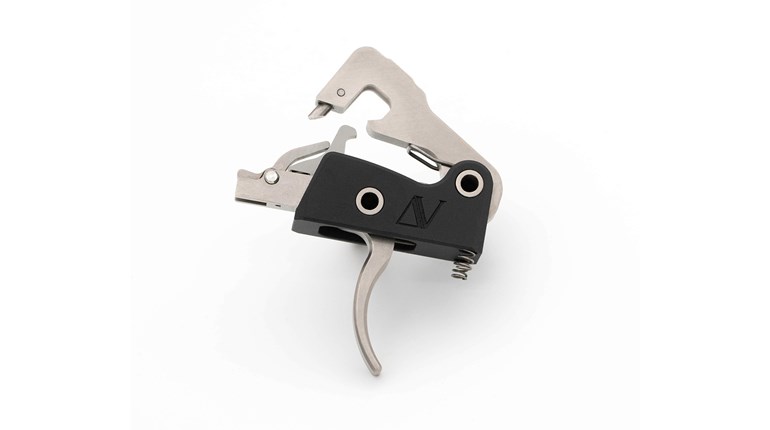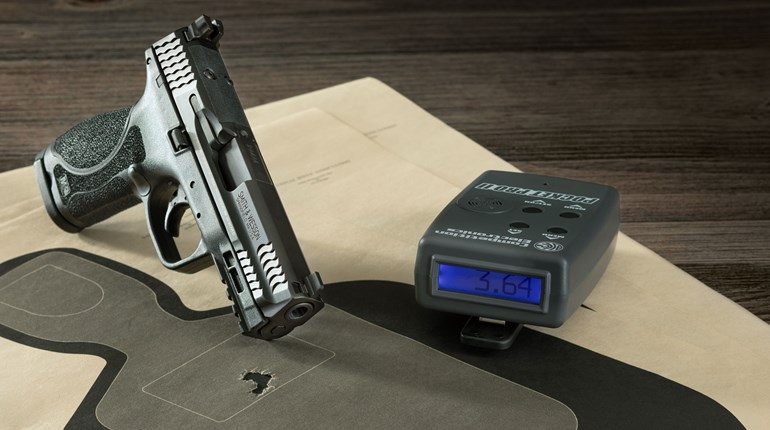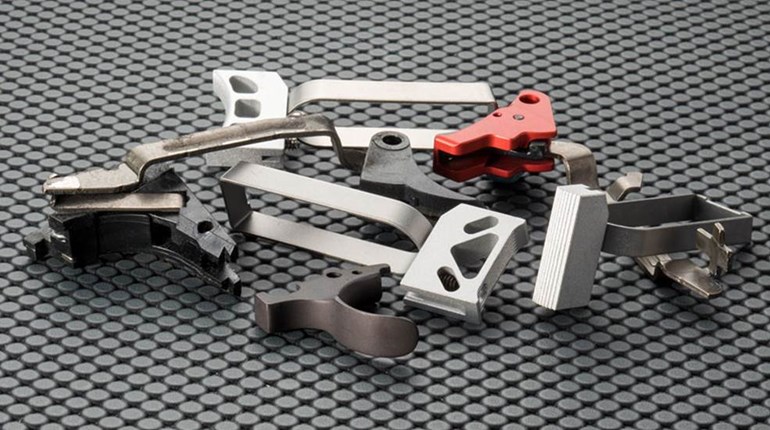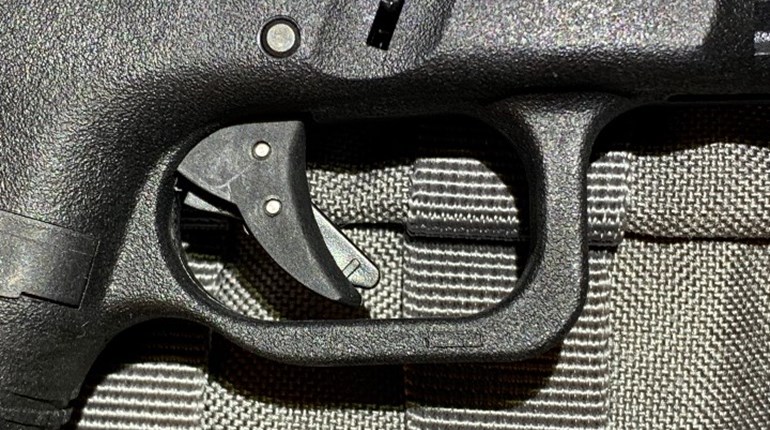
In Grip Architecture, we took a look at how to assemble the two-handed grip for a pistol or revolver. The architectural metaphor was useful in the sense that it implied a “solid” start; it’s less helpful if it evokes something that stays still for long. Handgunning is a dynamic pursuit in virtually every sense of the word, and proper mechanics are needed to control and direct that dynamism to make timely, accurate shots when you must, not merely when you wish.
The essence of good grip architecture is actually simple, though it bears review. First, it has to be safe. That means your finger is off the trigger, except as you transition into the shot itself, and your sights are on the target. Remember: You’re responsible for what’s behind that target, too.That means your finger is off the trigger, except as you transition into the shot itself, and your sights are on the target. Remember: You’re responsible for what’s behind that target, too.
Next, it has to be secure enough to fully control the handgun in recoil. To this end, we made suggestions about getting more of “you” on the pistol: The notions of unburying the thumb and collapsing into the final grip have hopefully reinforced this. The result should be roughly equal pressure on both sides of the firearm, as well as both thumbs on the same (weak) side. We didn’t make a big deal about crossing the thumbs “behind” the gun last time, but this is an old revolver technique that we cannot recommend under any circumstances: It positively invites a potentially serious injury to that weak-hand thumb if mistakenly transferred to an auto-loader. We advocate both thumbs on the same side of the handgun—always.
Note that we said “control” recoil. When you see a competent shooter running a powerful handgun with what appears to be little or no movement (and often rapidly and accurately, too), don’t talk yourself into thinking there’s some sort of magic or clever “cheat” going on. It just means that they have sound and well-practiced grip architecture and mechanics that minimize and distribute energy well. The energy itself is identical for everyone shooting that firearm. That Isaac Newton guy, remember?
Proper grip architecture also makes possible precise—even delicate—trigger actuation and sight alignment. Too tight is just as big a problem as too loose, though for different reasons, and that’s where grip mechanics enter the fray.
Three notions govern proper mechanics in our view. Conveniently, they have a simple mnemonic too: Press, press, press. Easy, right?
The first “press” is why “getting more of you on the gun” was a part of our architecture. Nearly even pressure should be applied to both sides of the grip, or we wind up doing what’s called “steering” of the handgun during recoil recovery. Some instructors assert that slightly uneven pressure is even advantageous if it comes on the "off" or weak side, and we agree. The rationale varies, but we favor it as a check on over-gripping and its damaging effect on trigger manipulation.
What we’re after here is actively, consciously pressing the palms together around the grip surfaces. This is in contrast to the conventional notion of squeezing for a deliberate reason: Squeezing involves the smallish muscles of the fingers and hands. Such hand/finger action is weak—in fact, very weak—when compared to the muscles on the insides of the arms and across the chest, as well as the outsides of the arms and across the back.
These inside/outside sets of muscles therefore act to vector recoil energy into a far larger set of (resisting, dissipating) muscles. In the old days, such “dynamic tension” was the goal of pushing the strong hand out against the weak hand as the shot was fired. Unfortunately, the “pull” acted along the axis of recoil and served to reinforce rather than abate it. It was good for a first shot perhaps, but unbalancing for each subsequent.Here’s the essence, and the goal: You’re trading skeletal absorption of recoil (by means of body mass) for muscular dissipation of recoil (through dynamic tension).
There’s another problematic holdover from push-pull. The strong arm is often very straight. While this has an extremely sturdy, steady feel, it has two body mechanics issues. If the elbow is actually locked, you are transferring recoil energy directly to the torso, and you will rock with every shot. This rocking motion can be cumulative to the point where it requires a step backward to arrest (the dead giveaway that this is happening). Equally detrimental is a geometry component: Your press of the pistol against the opposite palm will be lackluster.
The fix is simple: While maintaining proper architecture, simply don’t push the gun out as far. If you actually follow through with this (it’s a tough habit to break, we concede), you’ll notice an immediate, dramatic ability to press your palms together. It seems counterintuitive that to do this you must bend the elbows, but for most people this will still prove dramatically stronger. If you can watch a good shooter from above, this is one of the things most immediately apparent about good recoil control: The elbows aren’t locked. We’re agnostic on whether the elbows go down, or out—whatever allows you to press the palms forcefully is the way to go. (More on the Three "P's" here)
Here’s the essence, and the goal: You’re trading skeletal absorption of recoil (by means of body mass) for muscular dissipation of recoil (through dynamic tension). Guess which one is slow and positionally variable, up to and including inducing malfunctions, and which is faster, stronger and works all the time?
Our second “press” is simpler. Remember the time spent on thumb position? Here’s the payoff: A chief source of malfunctions in auto-loading handguns is poor wrist tension—the infamous “limp-wristing.”
An accurate term, it has the inconvenience of making no substantive suggestion about fixing the problem. A common and unhelpful prescription is to increase grip tension overall. This is a terrible idea for lots of reasons, but the two main ones you can probably anticipate. For one, you’ll be making delicate trigger actuation more difficult (it’s mighty tough to squeeze the pistol tighter with only the third, fourth and fifth fingers). Second, you simply don’t improve wrist tension all that much despite how it feels.
What does work is to push the strong hand thumb toward the target. If you do this properly in a short-sleeved shirt, you’ll see tension changes up to mid-bicep, to say nothing of the top and inside of the wrist, where it counts. Don’t overdo this, either: You’ll be surprised how little is required. A rough example is about twice the tension required to hold your phone vertically between your thumb and forefinger. If you’ll take our word for it, this has acquired “magic bullet” (pun intended) status for a surprising number of shooters over nearly a quarter-century, and made a similarly amazing number of pistols “stop” malfunctioning.Our suggestion is to work backwards: Press the trigger, press the thumbs, press the palms.
In press three, we transition from grip to shot. This is all about trigger actuation, and to some extent we admit is a bit of a word game. “Pull,” suggests an unhelpful haste, especially at the beginning of the action—a great way to misalign the sights. “Squeeze,” is a difficult practical matter in terms of execution given the structure of the hand and how the brain issues commands to it: It leads to side-to-side pressure inequalities that can wildly impact accuracy. “Jerk” condemns itself directly, though it’s the front end of “anticipating recoil,” and a physiological artifact at the root of most poor shots.
When you’ve committed to making a shot, then, press the trigger. This means a steady application of force to the trigger. Not necessary slow, mind, and certainly not heavy. The goal is to execute a steady overcoming of whatever mechanical force the trigger presents, but not at an increasing (or decreasing) rate. (Any rate change is technically “jerking” the trigger, if you think it through.)
Keep in mind this is difficult because it’s not how we’re wired. Most aspects of living in a physical continuum controlled by gravity teach us to respond with ever-increasing pressure until some environmental component conforms. The crucial word there is “increasing.” If you apply this to trigger press, it’s literally acceleration in the physics sense, and will result in movement of point of aim and subsequent impact.
We close with a few little housekeeping thoughts, and all in the form of additional advantages. The first “press” of the palms will make your shooting better as you move, because it’s far less bouncy than a skeletal lock/straight arm technique. In the wind, your now-closer hands are less of a “sail,” and you may literally be astonished how much difference it can make. For the second press, remember that “pointing” those thumbs has an aiming benefit, and pressing one (or both!) exaggerates this advantage. Last, pressing the trigger is a sine qua non to learning how to “follow the reset” as a trigger technique. This not-so-secret secret of the pros deserves consideration all its own because it has serious safety ramifications, but it’s also very useful when properly employed.
Like most technique changes, we can’t recommend trying to change too much at once. If things aren’t working, too many changes make (new) problems far more difficult to diagnose. Our suggestion is to work backwards: Press the trigger, press the thumbs, press the palms.
Now Carry on.
Read Part III here


































